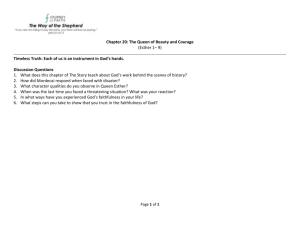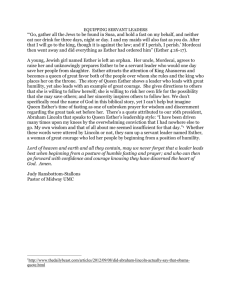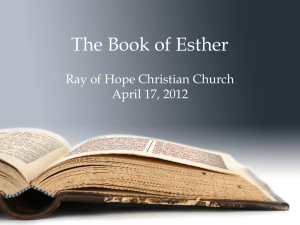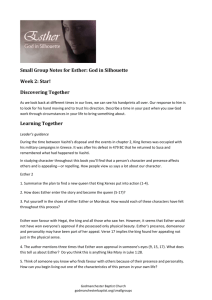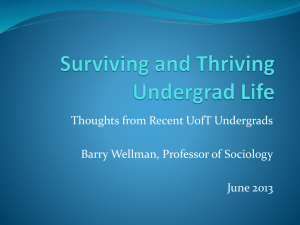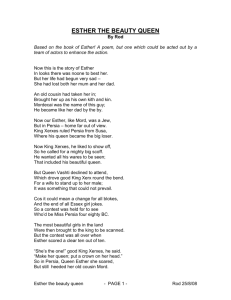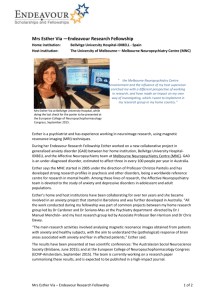Transvesting at Atlanta 1 Transvesting at Atlanta
advertisement
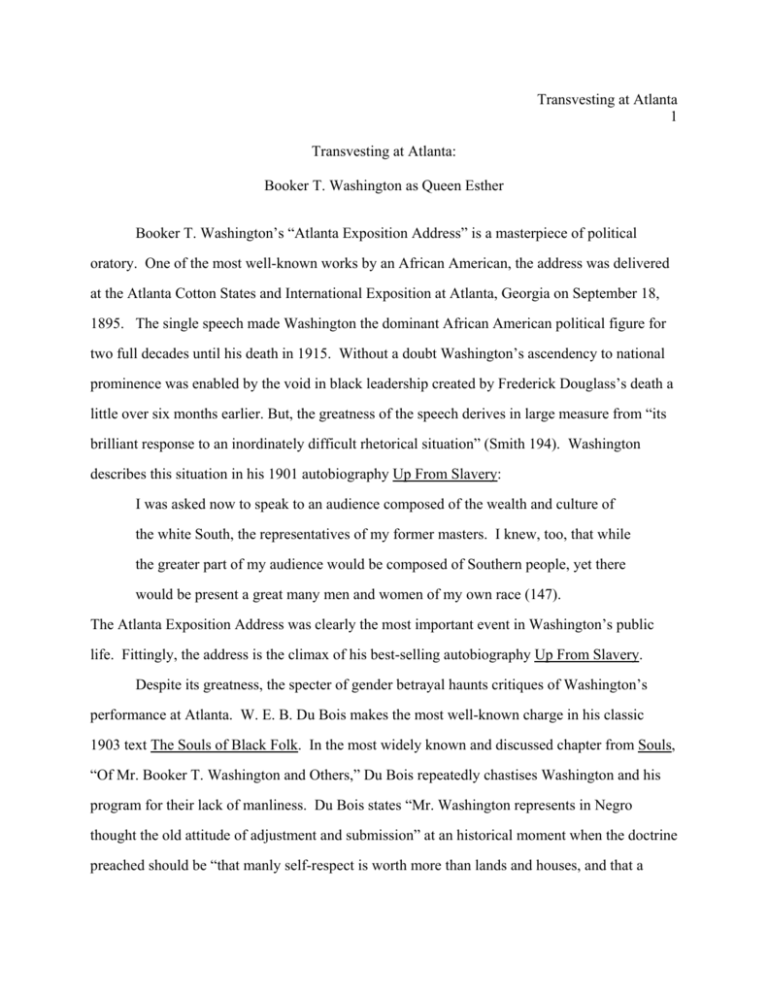
Transvesting at Atlanta 1 Transvesting at Atlanta: Booker T. Washington as Queen Esther Booker T. Washington’s “Atlanta Exposition Address” is a masterpiece of political oratory. One of the most well-known works by an African American, the address was delivered at the Atlanta Cotton States and International Exposition at Atlanta, Georgia on September 18, 1895. The single speech made Washington the dominant African American political figure for two full decades until his death in 1915. Without a doubt Washington’s ascendency to national prominence was enabled by the void in black leadership created by Frederick Douglass’s death a little over six months earlier. But, the greatness of the speech derives in large measure from “its brilliant response to an inordinately difficult rhetorical situation” (Smith 194). Washington describes this situation in his 1901 autobiography Up From Slavery: I was asked now to speak to an audience composed of the wealth and culture of the white South, the representatives of my former masters. I knew, too, that while the greater part of my audience would be composed of Southern people, yet there would be present a great many men and women of my own race (147). The Atlanta Exposition Address was clearly the most important event in Washington’s public life. Fittingly, the address is the climax of his best-selling autobiography Up From Slavery. Despite its greatness, the specter of gender betrayal haunts critiques of Washington’s performance at Atlanta. W. E. B. Du Bois makes the most well-known charge in his classic 1903 text The Souls of Black Folk. In the most widely known and discussed chapter from Souls, “Of Mr. Booker T. Washington and Others,” Du Bois repeatedly chastises Washington and his program for their lack of manliness. Du Bois states “Mr. Washington represents in Negro thought the old attitude of adjustment and submission” at an historical moment when the doctrine preached should be “that manly self-respect is worth more than lands and houses, and that a Transvesting at Atlanta 2 people who voluntarily surrender such respect, or cease striving for it, are not worth civilizing” (36). Washington’s “counsels of submission, ” Du Bois comments, “overlooked certain elements of true manhood” (32) and are bound “to sap the manhood of any race in the long run” (37). Du Bois’s critique of Washington as unmanly resonates in contemporary criticism of Washington. In the essay “Chapter One of Booker T. Washington’s Up From Slavery and the Feminization of the African American Male” Donald Gibson asserts that Washington assures white men that “black males neither are nor desire to be ‘men,’ in the nineteenth-and twentiethcentury traditional sense of that term” (96). David Lionel Smith continues this charge of Washington as effeminate in a claim that borders on the homophobic when he states that “Washington’s policy was a great success for Tuskegee and for himself, but Washington was an historical dead end. Militancy, not passivity (emp. added), was the emergent historical trend” (199). Smith’s use of phrases such as “dead ends” and “passivity” recalls the homophobic language that critic Leo Bersani identified in scientific writing and journalism about AIDS that compared the anus to a grave. Even a critics like David Howard-Pitney who views Washington positively in The Afro-American Jeremiad places the Wizard of Tuskegee in the feminine domestic sphere when he asserts that “Washington’s soothing recipe (emp. added) for national harmony and material progress was well-received in a nation eager to mute sectional controversies and turn single-mindedly to pursuing economic gain” (60). These criticisms of Washington as unmanly and effeminate depend upon negative valuations of women. The feminist critic Hazel V. Carby astutely points out this anti-woman bias in her recent collection Race Men. Carby unravels the complex gendered language of Du Bois’s criticism to show how it gains its rhetorical force through images of illicit sexual union. “Washington is not a man by Du Bois’s measure of black masculinity,”and, Carby continues, “his compromise with the dominant philosophy of his age is to be understood as a form of prostitution” (39). Du Bois’s renaming of the speech as “The Atlanta Compromise” continues Transvesting at Atlanta 3 degrading images of women. “The city of Atlanta–whether evoked through Washington’s ‘Atlanta Compromise’ speech or as the symbolic landscape of commercial degradation in The Souls of Black Folk–is a female entity, historically compromised and starkly contrasted to the modern nation evoked as ‘this common Fatherland’” (39-40). This essay takes seriously the critique of Washington as effeminate and Carby’s observations that these critiques are hostile to women. I believe that Washington assumes a feminine role, or “second persona” to use Edwin Black’s term in the Atlanta Exposition Address. However, I do not believe that Washington “sells-out” black males when he assumes that role. I propose to examine Washington’s performance at Atlanta as an act of “transvesting,” what religious scholar Timothy Beal in The Book of Hiding defines as a “masquerade” in which “one crosses over a boundary line between identities that are culturally conceived as opposites (transvesting = ‘dressing across’)” (123). Viewing Washington’s address as transvesting allows me to make several points. First, transvesting as a model mediates between critical disagreements, so I am able to show how Washington is effeminate and at the same time that Washington does not perform a degrading image of women. Second, Washington’s masquerade at Atlanta affirms African American cultural practices. Washington’s transvesting as the Biblical Queen Esther actually affirms a highly valued black feminine tradition since it is entirely consistent with African American readings practices of the Bible and cultural practices. Furthermore, Washington’s masquerade is consistent with African American trickster practices that survived the Middle Passage and were transformed on American soil. Studying Washington’s text as transvesting allows for an insider perspective that validates rhetorical performances and traditions internal and within African American culture. Finally, the model of transvesting allows us to see that desire plays an important, though seldom acknowledged role, in oratory. Transvesting at Atlanta 4 Black Women Perform the Epic of Queen Esther Allow me to give a brief synopsis of The Book of Esther: The Persian king Ahasuerus [Xerxes] has deposed Vashti, his queen, and decides to find a new one. A young Jewish girl named Esther wins his favor and becomes the new queen. She follows the advice of her uncle and does not reveal her Jewish identity. Her uncle Mordecai becomes involved in a quarrel with the king’s vizier, Haman. Haman plots to slaughter all the Jews in the empire to revenge himself against Mordecai. His plot is discovered. Esther reveals her Jewish identity to the King and through her efforts, Haman is executed and the enemies of the Jews destroyed. Mordecai becomes the king’s new vizier. The Jews institute the festival of Purim to commemorate Esther.1 This fast-paced tale of court intrigue is notable since it is one of the few books of the Bible in which a woman is the protagonist. Despite the Book of Esther’s unique status rhetoricians and scholars of oratory have ignored, for the most part, Queen Esther as a model for oratorical performance. When they have paid attention to the Book of Esther, often it is to define Queen Esther as too narrow a role for women. Phyllis Japp’s assessment of early nineteenth century women’s rights activist Angelina Grimke is typical. Grimke’s stance at the speaker’s platform as Queen Esther, Japp states, “epitomized the position of women in nineteenth-century society. While they were elevated to a position of moral supremacy, they possessed no power save the power to plead” (341). Japp This synopsis is based upon the King James Version of the Bible. Subsequent references to The Book of Esther refer to this translation. The Book of Esther in the King James translation more closely follows the Hebrew version of the story. The Hebrew version of the story is notable because it is the only book of the Bible in which the word God does not appear. The Greek version of the Book of Esther contains prayers to God and appears in Catholic translations. Obviously, Protestant-oriented African Americans who are mostly the subject for this study would have been more familiar with the Hebrew story that appears in the King James translation. 1 Transvesting at Atlanta 5 concludes that Queen Esther is negative for women since her character is “rooted in low selfesteem, an acceptance of the validity of one’s place in the social order” (344). Ultimately, Queen Esther is merely a character “controlled by the scene in which she lives: the static, traditional world of male dominance” (Japp 344). The perspective of African American women differs dramatically from the one that Japp describes. Historically Black women have drawn explicit and implicit parallels between themselves and the Biblical Queen in ways that mirror African American uses of biblical texts. The folklorist John Roberts comments that enslaved African Americans found “a narrative core around which they could develop an heroic epic” in the story of Moses and the Israelites and their heroic struggle with the Pharaoh and the Egyptian enslavers (149). Likewise African American women found in Queen Esther an epic figure for their struggles. Black women viewed the biblical Queen Esther as a precedent for women’s right to speak in public since the beginning of their campaign for the speaker’s platform. Nineteenth century women “voice merged,” to borrow the words of Keith Miller, with Queen Esther when they interpolated into their texts passages from Esther or restatements and paraphrases of those passages. Defending her right to speak in public, Maria W. Stewart, dubbed “America’s first black woman political writer,” made explicit parallels between herself and Queen Esther. In an 1833 address Stewart asked her Boston audience “What if I am a woman; is not the God of ancient times the God of these modern days? . . . Did not queen Esther save the lives of the Jews?” (68). The legendary Sojourner Truth also made explicit reference to Esther in a speech she delivered at the Fourth National Woman’s Rights Convention held in New York in 1853. Arguing for the right of women to publicly agitate for equal rights, Truth, for all intents and purposes, summarized the Book of Esther: I was a’thinkin’, when I see women contendin’ for their rights, I was a’thinkin’ what a difference there is now, and what there was Transvesting at Atlanta 6 in old times. . . . in the old times the kings of the earth would hear a woman. There was a king in the Scriptures; and then it was the kings of the earth would kill a woman if she come into their presence; but queen Esther come forth, for she was oppressed, and felt there was a great wrong, and she said I will die or I will bring my complaint before the king. Should the king of the United States be greater, or more crueler, or more harder? But the king, he raised up his scepter and said: “Thy request shall be granted unto thee--to the half of my kingdom will I grant it to thee!” Then he said he would hang Haman on the gallows he had made up high. But that is not what women come forward to contend. The women want their rights as Esther. She only wanted to explain her rights. And he was so liberal that he said, “the half of my kingdom shall be granted to thee,” and he did not wait for her to ask, he was so liberal with her (Qtd. in Lerner, 567-568) Long after they had won the right to speak in public secular settings African American women continued to cite The Book of Esther as a precedent for women participating in public life and as a role model for black women. At the turn of the century Mary Morris Talbert, a leader of the National Association of Colored Women who was widely “known for her oratorical skills” and always in demand as a lecturer “enjoyed telling audiences about the lessons that could be drawn from the Old Testament Book of Esther” (Williams 1137). For Talbert Queen Esther was a role model for race pride, loyalty, and commitment to civil rights. Educator and club woman Emma Azalia Hackley found Esther an appealing role model for young African American girls. Hackley wrote in her 1916 primer The Colored Girl Beautiful that each African American girl “must be taught the application of the story of Esther to her race. Tell her that Transvesting at Atlanta 7 each colored girl may be an Esther, especially in all matters of cleanliness, manners, and selfsacrifice, to advance and change the prevalent opinion of the Negro” (Qtd. in Karpf, 1999, p. 614). Black women in religious circles found Queen Esther an appealing figure for their struggles. In 1887 the theologian Mary V. Cook echoed Maria Stewart at an annual meeting of the American National Baptist Convention by referring to the “queenly patriotism of Esther” as proof that women could assume more important leadership roles in the Baptist church. Nineteenth century black Baptist women viewed Queen Esther as a figure for civil rights activism as they made evident when they wrote of anti-lynching crusader of Ida B. Wells that we have “found in our race a queen Esther, a woman of high talent, that has sounded the bugle for a defenseless race” (Qtd. in Higginbotham, 143). Queen Esther was also a recurring figure in the aesthetic endeavors of black women. The writer Frances Ellen Watkins Harper revered the defiance of Esther’s antecedent, Queen Vashti. The poem “Vashti” from 1871 is, according to one critic, characteristic of Harper’s “feminist revisions of biblical interpretations” (Boyd 73). In verse Harper celebrated Queen Vashti as “Strong in her earnest womanhood” and her refusal to parade herself before the King and his guests left her Proud of her spotless name, A Woman who could bend to grief, But would not bow to shame” (182). Queen Esther resurfaces again in Harper’s 1892 novel Iola Leroy. This time, Harper creates an “analogy between the mulatta woman and the assimilated Jew” (Berlant 472). Marie, the mother of the novel’s protagonist, gives a public speech on the day she graduates from the ‘finishing’ school that will enable her to pass as the white wife of Albert Leroy: “Like Esther pleading for the lives of her people in the Oriental courts of a despotic king, she stood before the Transvesting at Atlanta 8 audience, pleading for those whose lips were sealed, but whose condition appealed to the mercy and justice of the Nation” (75). Musicologist Juanita Karpf has demonstrated that black women were extremely important for the success in America of William B. Bradbury’s popular1856 oratorio Esther; the Beautiful Queen. The oratorio was reprinted several times between 1856 and 1924 and had sold 255,000 copies by 1868. The oratorio was a vehicle for African American concert singers, including Maggie L. Porter Cole who was a soprano with the original Fisk Jubilee Singers, and the singer, teacher, writer and journalist Amelia L. Tilghman (1856-1931). Tilghman first heard the oratorio at the Louisville, Kentucky Saengerfest in 1881 and it so impressed her that she staged it and performed as Queen Esther in two performances in Washington, D.C. in the same year (Karpf 1999; Karpf 2000). An important reason for Queen Esther’s popularity with black women is that her role as a mediator between a subordinated people and those in power mirrored the view that black women held of themselves. This belief was widely held among middle class black Club Women as the nineteenth century turned into the twentieth. The historian Deborah Gray White commented in a radio interview that black club women believed that “black men were really not able, and in some cases not capable of leading the race and that black women being more moral, more altruistic, being more in touch with the real needs of black people [and] that in fact black women were the salvation of the race far more than black men.” This idea that black women were more suited to be leaders of the race depended upon a view of black women as mediators between black and white worlds. Juanita Karpf comes to a similar conclusion in her study of Tilghman’s choice of the oratorio Esther; the Beautiful Queen. Karpf comments that Tilghman’s choice was neither “casual or serendipitous,” but a profound identification which many black women shared with an Old Testament “diaspora novella . . . [that] imparts lessons of social justice, racial identity, mediation, and solidarity” (613). Historian Elizabeth Higginbotham study Transvesting at Atlanta 9 of Black Baptist confirms black women’s view of Queen Esther as a mediator between black and white peoples. Black Baptist women viewed Queen Esther as an intermediary between the King and her people and viewed themselves in an analogous manner “as intermediaries between white Americans and their own people” (Higginbotham 143). Queen Esther Speaks When African American women read Queen Esther as a heroic figure mediating between black and white worlds they were reading her in the tradition of the Hebrew Bible “wisdom tale,” the purpose of which was to teach Jews how to live a successful life in diaspora. Michael V. Fox comments on the overall purpose of this corpus of literature: Jews in exile used stories to shape behavior and attitudes and to come to grips with certain questions of great urgency: How do we meet the threats to our existence now that we have no state, no king to command us, no army to defend us, no territory to localize the defense, no temple to pray and sacrifice in, no priests to instruct us and lead communal prayer(148)? Other books in the Hebrew Bible also address this problem, both directly and indirectly. Nehemiah and Daniel, for example, are Jews who rise in prominence in gentile courts while maintaining their religious integrity. Sidnie Ann White brilliantly points to the wisdom that Queen Esther offers to Jews: The Jews in the Diaspora also are in the position of the weak, as a subordinate population under the dominant Persian government. They must adjust to their lack of immediate political and economic power and learn to work within the system to gain what power they can. In the book of Esther, their role model for this adjustment is Esther. Not only is she a woman, a member of a perpetually subordinate population, but she is an orphan, a powerless member of Jewish society. Therefore, her position in society is constantly precarious, as was the Transvesting at Atlanta 10 position of the Jews in the Diaspora. With no native power of her own owing to her sex or position in society, Esther must learn to make her way among the powerful and to cooperate with others in order to make herself secure” (167) In this sense the Book of Esther addresses through storytelling how Jews can live in diaspora. African American women reading Queen Esther as their own wisdom literature were continuing a tradition of transforming Biblical, particularly more Jewish Old Testament texts of bondage, to explain and negotiate American black experiences of enslavement and subordination. When African American women turned to The Book of Esther, and its royal subject for wisdom, they discovered virtually “a dictionary of survival techniques” (White 166). Allow me to discuss the survival techniques which are pertinent for this discussion of an oratorical model. The Jews in The Book of Esther are successful courtiers. They are not, as Elias Bickerman notes, “the uncouth patriarchs and the wild prophets,” but rather they are sophisticated courtiers and “men of polite society” who could easily have a place in a royal court (Bickerman 205). Their rhetoric is equally refined. That is to say, theirs is a rhetoric that is finely honed for what the black feminist critic bell hooks calls “talking back,” the defiant speech of “the oppressed, the colonized, the exploited . . . that makes new life and new growth possible” (9). Esther’s rhetoric is a case in point. Her petition delivered in Esther 8:5 is, as one scholar has noted, a “masterpiece of courtier’s rhetoric” (Clines 123). She prefaces her petition with four conditional clauses: ‘If it please the king, and if I have found favor in his sight, and if the thing seems right before the king, and I be pleasing in his eyes.’” White notes the strategic importance of these clauses: The first two are familiar from earlier speeches by Esther . . . the third and fourth are newly composed for the occasion. In these third and fourth clauses she shifts the responsibility for overturning Haman’s decree onto the king (‘if the thing Transvesting at Atlanta 11 seems right before the king’) and again appeals directly to her relationship with him (‘and I be pleasing in his eyes’). (173) Although on the surface her speech is merely that of a polite courtier, underneath she is giving the reasons why her request should be granted. Esther plays to the hilt the role of the wise courtier. She is aware of power differences between herself as representative of a subordinated people and the King and his trusted and dangerous advisor Haman. She uses flattery, appeals to emotion, and the submissive behavior of the supplicant. Traditional Aristotelian and neo-Aristotelian rhetoric eschews these techniques as unethical and morally vacuous since these rhetorics assumes a democratic polis. However, the rhetoric of the royal court with its vast power hierarchy is anything but democratic. Survival of the Jews can only come about when Esther overcomes her reluctance to speak to the King and when Esther reinforces the bonds of ethnicity and kinship among the Jews. Feminist scholars have questioned whether Esther’s speaking stresses the bonds of ethnicity and kinship over that of solidarity to members of her gender. After all, Esther comes into power only by replacing the dethroned Vashti. This premise helps to explain the ambivalence or even outright hostility toward Esther as a role model that one often encounters in mainstream discourse about the influence of women in the Bible (Beal 42-49; Japp 335-348; Sedgwick 75-82). For instance, queer theorist Eve Kosofsy Sedgwick recalls that in her childhood masquerading as Esther was used to teach girls feminine gender roles-- “fondness for being looked at, fearlessness in defense of ‘their people,’ nonsolidarity with their sex” (82). However, the Book of Esther does not necessarily exclude gender solidarity within the bonds of kinship and ethnicity. While the biblical narrative clearly aligns Esther and Vashti against each other, that is, Esther replaces Vashti as the queen, it is clear that Esther and Vashti share neither kinship nor ethnicity. It seems more reasonable, then, to view the Esther-Vashti relationship not as a statement against gender solidarity, but as a statement about kinship and Transvesting at Atlanta 12 ethnicity. The absence of gender solidarity without kinship and ethnic commonality mirrored the racial realities of African American women throughout the nineteenth century and well into the twentieth century. The black women’s club movement was a direct consequence of the exclusion of black women from the white women’s club movement. Yet, the absence of gender solidarity with white women, neither prevented African American women from identifying with Queen Esther nor did it stand in the way of them strengthening the bonds of solidarity as African American women. The formation of the black women’s club movement is a case in point since it sought to strengthen the bonds of gender solidarity within their racial group and it viewed this solidarity as benefitting not only themselves, but the entirety of the race. This was the meaning behind one of the most memorable passages in Anna Julia Cooper’s 1892 A Voice from the South: Only the Black Woman can say “when and where I enter, in the quiet, undisputed dignity of my womanhood, without violence and without suing or special patronage, then and there the whole Negro race enters with me” (29). It seems reasonable to conclude that the figure of Queen Esther as a savior for her people is entirely consistent with black women’s political organizing, especially, when those issues are defined in what historian Elsa Barkley Brown calls “womanist” terms that reflect a “belief in the possibilities inherent in the collective struggle of black women in particular and in the black community in general” (618). In general, then, Queen Esther as a model for speech contains the following elements: [1] speech that emphasizes the significance of cooperation to strengthen the bonds of ethnicity and kinship; [2] a belief that women are invested with the ability to make decisions that benefit the group; [3] the necessity to speak truth to power when social, cultural, or political conditions discourage subordinated individuals from speaking. As bell hooks points out “talking back” is “no mere gesture of empty words,” rather it is “the expression of our movement from object to Transvesting at Atlanta 13 subject—the liberated voice” (9); [4] the discovery and use of strategies that enable one to be heard; and, [5] an emphasis on mediation between the dominated and the domineering in order to raise the status of the dominated. A Manly Esther Booker T. Washington’s background may have been an important reason that he could assume the persona of Queen Esther. Washington, whose first seven years were as an enslaved person, acquired the survival values of the plantation. In particular, Washington learned to bend the truth and play on it as a consummate trickster. Frederick McElroy notes the persistent presence in Washington’s autobiographies, published speeches, and other writings of the trickster John tales, “those humorous anecdotes structured around the motif of the slave or freedman who outwits his master or another white person” (95) McElroy goes on to show how Washington skillfully assumes this trickster persona, so that often it is difficult to tell when the Wizard of Tuskegee is “lyin’ and signifyin’” and when he is telling the truth. Perhaps the most compelling argument that Washington viewed himself as a trickster occurs in his own autobiography Up From Slavery, when he locates his own birth “near a cross-roads post-office” (1). The cross-roads is the typical site for the trickster and the post-office alludes to the tricksters vital role in communication and interpretation, that is, hermenuetics, the discourse of the Greek trickster messenger god, Hermes. Viewing Washington as a trickster allows us to understand how he could so deftly assume the feminine persona of Queen Esther. Sexual indeterminancy is a frequent characteristic of tricksters. Eshu Elegbara, the trickster that Henry Louis Gates, Jr. identifies as the progenitor of African American literature, is such a gender transgressing figure. It is highly possible that Washington as a trickster saw no problem with appropriating feminine discursive strategies. Washington’s appropriation of the Queen Esther persona is best understood when one Transvesting at Atlanta 14 examines The Atlanta Exposition Speech as it appears in Up From Slavery. Structurally the address appears as the fourteenth of seventeen chapters. More importantly, Washington clearly positions The Atlanta Exposition Address chapter as the climax of his autobiography. The chapters that follow it merely relate how he dealt with his success post Atlanta. Further, it is worth noting that when Washington assumes Queen Esther’s persona he also abandons the more manly Moses stance that he had assumed earlier in the text, for instance, as in chapter ten whose title is significantly “A Harder Task than Making Bricks Without Straw,” clearly an allusion to the role Moses played in delivering the Hebrews from Egyptian enslavement. As a trickster figure in his autobiography, Washington can be both Esther and Moses. Washington develops the Esther persona for the Atlanta address in chapter thirteen. Washington opens the chapter about the beginning of his public speaking career in a curious manner of describing his goal of educating all black students without regard for their inability to pay for their education. This oddly placed “prologue” of sorts tells little about Washington as an orator, except it does establish his commitment as a deliverer for his people. Washington then proceeds to tell about a speech he gave in Madison, Wisconsin at an annual meeting of the National Education Association. Washington gives this speech especial importance considering it “the beginning of my public speaking career” (139). It is, in a sense, the beginning of his Esther-like audition for the position of leader of his race. Like Esther, Washington has a Mordecai figure in General Armstrong, the head of Hampton Institute who became Washington’s lifelong mentor. Armstrong arranges for a reluctant Washington to speak in Madison. Washington proclaims his reluctance to speak commenting that “I have always had more of an ambition to do things than merely to talk about doing them” (139). Washington overcomes his reluctance and reveals himself to be the wise courtier when he discusses preparing for this speech. He implies that he is motivated to be fair and balanced vowing “never to say anything in a public address in the North that I would not be willing to say Transvesting at Atlanta 15 in the South” (140). Yet, immediately after this avowal of equanimity, Washington points to the need for strategy, specifically flattery and indirection, when addressing more powerful white Americans: “I early learned that it is a hard matter to convert an individual by abusing him, and that this is more often accomplished by giving credit for all the praiseworthy actions performed than by calling attention alone to all the evil done” (140). Washington goes on to note that in his address he emphasized cooperation between the races. Washington gives as examples stories that he told his audience about how successful interracial cooperation had increased the wealth of blacks and whites in Tuskegee. After securing his audience’s good will with stories about industrious black agricultural students and white farmers who “respected and honored” them, Washington, then, laid out his philosophy of education in which cooperation with whites “could lay the foundations upon which his [student’s] children and grandchildren cold grow to higher and more important things in life” (141-142). Washington credits this speech with giving him “a rather wide introduction in the North” that resulted in “opportunities” to address Northern audiences (142). Washington’s locates his more formal audition for race leader with an address in Washington, D.C. before the House Committee on Appropriations. In the spring of 1894 several prominent Southern white businessmen and politicians organizing what would become Atlanta Cotton States and International Exposition invited three African American men to accompany them to Washington, D. C. Their purpose was to request funds from the House Committee on Appropriations. Along with Washington, the other two men were Bishop Abram L. Grant of Texas and Bishop Wesley J. Gaines of Georgia. All three of these men could be counted on to make statements that would not offend white southerners. At the hearing before the Appropriations Committee, when the white men finished speaking, only a few minutes remained for Washington, Grant, and Gaines to speak In what was an audition for the right to speak and to represent the race at the forthcoming exposition, Washington thoroughly charmed Transvesting at Atlanta 16 the audience according to eye-witness accounts (Harlan 206-207). After deliberating for several days about a speaker to “represent the Negro race,” the Board of Directors, “composed of men who represented the best and most progressive element in the South,” Washington writes in a very complimentary manner, chose him. Washington’s analogy of himself to Queen Esther, and representations of her, is overwhelming at this point of the thirteenth chapter. He is reluctant to speak when he remembers that his humble origins as a slave whose early years “had been spent in the lowest depths of poverty and ignorance,” that only “a few years before that time that any white man in the audience might have claimed me as his slave,” and, moreover, that it was “easily possible that some of my former owners might be present to hear me speak” (147). Washington sees danger in speaking. The danger that Washington identifies is that when he speaks, “I must be true to my own race,” yet knowing “I had it in my power to make such an ill-timed address as would result in preventing any similar invitation being extended to a black man again for years to come” (147). As the day for the address approaches, Washington’s perception of danger becomes palpable. Washington writes , “I felt a good deal as I suppose a man feels when he is on his way to the gallows” (148). What brings about this perception of death before speaking? One of the most popular representations of Queen Esther is of her fainting after her unbidden entry into the King’s chambers. This image of Queen Esther occurs both in Handel’s 1718 oratorio Esther and Jean Racine’s 1721 drama of the same name. Popular paintings also depict this scene, notably in “Esther Before Ahasuerus” (ca. 1628-35) by Artemisia Gentileschi (1593–1651/53) frequently acclaimed by critics as the most important female artist before the twentieth century. These representations of Esther’s collapse refer to the transgression that has taken place. Esther comes before the King unannounced and without the permission of the court eunuchs. Death was the penalty for entering the King’s chambers unbidden. However, the King accepts Esther’s intrusion into his chambers, in an act redolent with erotic significance. The Transvesting at Atlanta 17 King extends his golden scepter to Esther and she touches the tip of it. Then, she collapses, presumably from nervous exhaustion. Timothy Beal writes that the danger of Esther’s transgression is that she “insists on being a subject in the same way that Vashti had refused to be an object” (76). The danger for Washington was that like Esther, his speaking that day meant that he would be “operating in spaces neither organized nor consolidated along the lines of the king’s more ostensible royal power structure” (Beal 77). The king, or in this case “the men who represented the best and most progressive element in the South,” have political authority over the speaker’s platform, but they are unable to consolidate every point of power and identify it for the furtherance of white supremacy. Needless to say, when Washington finally reached the exposition grounds “the heat, together with my nervous anxiety, made me feel as if I were about ready to collapse” (150). Washington has become a queer, Queen Esther. A Signifyin’ Queen On the surface Washington’s speech is that of a polite courtier, but underneath he is like Queen Esther giving the reasons to why his petition should be granted. Washington appeals to the audience’s emotions rather than use cool logic at the outset of the address. Note, for instance, the implied threat in the first two sentences of his address: “One third of the population of the South is of the Negro race. No enterprise seeking the material, civil, or moral welfare of this section can disregard this element of our population and reach the highest success” (151). While this appears to be a fact, it also positions blacks as integral to the future of the South. Washington follows up this statement with what appears to be pure flattery. Claiming to express “the sentiment of the masses of my race,” Washington makes the outrageous assertion, that “in no way have the value and manhood of the American Negro been more fittingly and generously recognized than by the managers of this magnificent Exposition” (152). Continuing, Washington states that this Exposition “is a recognition that will do more to cement the friendship of the two races than any occurrence since the dawn of our freedom.” Critic Transvesting at Atlanta 18 David Lionel Smith finds particular fault with Washington’s opening remarks. Smith comments that if Washington’s statements are literally true, then “Washington rates participation in an agricultural fair above the Reconstruction Acts, the Thirteenth and Fourteenth Amendments, the Civil Rights Act of 1875, and the creation of Howard and other Negro colleges, including his own Tuskegee Institute” (p. 197). However, if one looks at Washington’s remarks as a case of him “lyin’ and signifyin’” it is possible to see how he is careful not to put his audience on the defensive by pointing to white betrayals of black freedoms won during Reconstruction. In fact, Washington downplays Reconstruction successes in several places in the speech. For Washington Black participation in Reconstruction governments confirms that “in the first years of our new life [in freedom] we began at the top instead of at the bottom; that a seat in Congress or the state legislature was more sought than real estate or industrial skill; that the political convention or stump speaking had more attractions than starting a dairy farm or truck garden” (152). Later in the speech Washington chastises his people who “in the great leap from slavery to freedom” may have overlooked “the fact that the masses of us are to live by the productions of our hands,” who have not learned “to draw the line between the superficial and the substantial, the ornamental gewgaws of life and the useful,” and who have not yet learned “that there is as much dignity in tilling a field as in writing a poem” (153). Then Washington plays his “trump card”: the nostalgia gripping the nation at the end of the century for a view of an idyllic Old South. Smith is correct when he points out that nostalgia for a Golden Age of the South “forms the dominant undercurrent of” the Atlanta address (197). Washington urges blacks to “cast down your bucket” by seeking cooperation with Southern whites. Washington promises whites that in return “you can be sure in the future, as in the past, that you and your families will be surrounded by the most patient, faithful, law-abiding, and unresentful people that the world has seen” (154). Washington calls forth an image of loyal Transvesting at Atlanta 19 black aunties and uncles who were content in the past “in nursing your children, watching by the sick-bed of your mothers and fathers, and often following them with tear-dimmed eyes to their graves” (154). Historian Ralph Luker argues that Washington’s “cast down your bucket” image successfully repudiated the back to African movement that African Methodist Episcopal Bishop Henry McNeal Turner endorsed (54-55). While I do not disagree with Luker, I think that the fact that Washington surrounded “cast down your bucket” with nostalgic images requires further comment. Washington uses his trump card, nostalgia, to refer to the presence of a threatening Other. Just as Esther ordered the extermination of Haman and the Agagites, Washington embraces a zesty xenophobia. He contrasts loyal and faithful blacks with “the incoming of those of foreign birth and strange tongue and habits” (153). Washington pleads with whites to “cast down your bucket” with the “eight millions of Negroes whose habits you know, whose fidelity and love you have tested” rather than with immigrants. African Americans, Washington contends, have proven their loyalty “without strikes and labour wars” associated with immigrants (153). Washington guarantees whites that African Americans “shall stand by you with a devotion that no foreigner can approach, ready to lay down our lives, if need be, in defence of yours, interlacing our industrial, commercial, civil, and religious life with yours in a way that shall makes the interests of both races one” (154). Washington’s anti-immigrant sentiment requires a re-evaluation of the most famous passage from the Atlanta address. Washington announces that “In all things that are purely social we can be as separate as the fingers, yet one as the hand in all things essential to mutual progress” (154). Scholarly interpretation usually falls into two camps about this statement. One camp views it as the crux of Washington’s compromise with whites: blacks will cease agitation for civil rights in exchange for material prosperity. Du Bois referred to this compromise as Transvesting at Atlanta 20 Washington counselling “submission” in his famous critique in The Souls of Black Folk. Another camp, considerably smaller, views it as an articulation of Washington’s economic nationalism that later influenced Marcus Garvey and other twentieth century Pan-Africanist movements (Cruse 156-167 ). Neither of these camps fully grasps the meaning of this passage. While it may be a statement of compromise or economic nationalism, it also has another referent. Timothy Beal in his commentary on The Book of Esther remarks that Haman’s plan for the removal of Jews is a fantasy whose purpose “is to remove all otherness and to establish unity and wholeness” (55). In this respect Haman’s fantasy can be found in the “identity politics” of blackface minstrelsy that transformed nineteenth and early twentieth century European immigrants into white citizens. Houston Baker in Turning South Again: Re-Thinking Modernism/Re-Reading Booker T. comments: “Through racialized blackface, a white American artisante became a white ‘class’” (67). Blackface minstrelsy, Baker notes, provided whites with “a common symbolic language–a unity–that could not be realized by racist crowds, by political parties or by labor unions” (68). Washington’s xenophobia reveals an astute comprehension of the fantasy of a national white “unity and wholeness,” to borrow Timothy Beals language, which plans the elimination of his people. Queen Esther asked the King, “how can I endure to see the destruction of my kindred?” (8:8) when she requests permission to eliminate the enemies of her people. Esther does this only after she is assured that she is the King’s favored. The success of Washington’s nostalgia is that he has ascertained that he is the favored one, his famous phrase that “we can be as separate as the fingers, yet one as the hand in all things essential to mutual progress” counters minstrelsy’s fantasy of a white nation. Conclusion Washington transvests as Queen Esther because like the ancient heroine, he finds himself in the competitive and hierarchical world of the court. The United States at the turn of the Transvesting at Atlanta 21 century is like this court. The nation is hardly a democratic state. Black gains made during Reconstruction have been rolled back. Whites had successfully disenfranchised blacks, removed them from holding public offices, repealed the Civil Rights Act of 1875, and reduced the majority of African Americans in the South to a perpetual status of debt peonage. In 1895, the year that Washington delivered his address, 171 African Americans had been lynched by violent and retributive whites (Smith 198). Washington intervenes on behalf of his people adopting the persona of Queen Esther and mediating on behalf of them with powerful white men. His predominating strategy of nostalgia Signfies, to use the language of Henry Louis Gates, Jr., on Queen’s Esther’s plea that “If it please the king, and if I have found favor in his sight, and if the thing seems right before the king, and I be pleasing in his eyes.” Washington’s success is the equivalent of him having found favor in the eyes of white males in power in his audience. Washington’s xenophobic remarks about immigrants counters the white racial formation that was occurring at the end of the century. Blackface minstrelsy was an essential component of this new white racial group. European immigrants were hardly innocent when they embraced blackface minstrelsy as a means to gain greater rights for themselves by disempowering through performance African Americans. Washington’s masquerade reflects Queen Esther’s grisly deduction that the enemies of her people must be destroyed if the Jews are to be safe. In other words, Queen Esther’s actions are a “successful instance of Jewish self-defense” (Gevaryahu 3). Washington’s performance at Atlanta disturbingly mirrors Queen Esther’s salvation of her people. Queen Esther’s strategies, and Washington’s enactment of them, suggests the acknowledgement of desire as a part of the process of oratory. More specifically, this desire is homoerotic, in the spectacle of a black male performing before an audience of white males. In a chapter of Turning South with the scintillating title “Modernism’s Performative Masquerade: Mr. Washington, Tuskegee, and Black-South Mobility,” Houston Baker asks “Am Transvesting at Atlanta 22 I saying there existed a deeply homoerotic bond between Booker T. Washington and all white men . . . ? Yes” (73). Washington’s transvesting as Queen Esther appeals, perhaps, to a white male desire for black men that is a foundation of American culture. Leslie Fiedler explored this thesis in Love and Death in the American Novel through the recurring image in white male authored literature of white and dark male couplings. More recently this image is repeated endlessly and circulated globally in interracial male bonding films in which black males, more often than not, become nursemaids to wounded white males (Ames 52-60). In his Atlanta address Washington skillfully engages in transvesting as the biblical Queen Esther whose ability to protect her people is in large part derived from her skillful ability to manipulate the King’s desire for her. Washington proves equally adept at manipulating white male desire for himself. Transvesting at Atlanta 23 Works Cited Ames, Christopher. “Restoring the Black Man's Lethal Weapon: Race and Sexuality in Contemporary Cop Films,” Journal of Popular Film and Television 20.3 (Fall 1992):52-60. Baker, Houston A. Turning South Again: Re-Thinking Modernism/Re-Reading Booker T. Durham and London: Duke University Press, 2001. Beal, Timothy K. The Book of Hiding: Gender, Ethnicity, Annihilation, and Esther. New York and London: Routledge, 1997. Bersani, Leo. “The Gay Outlaw.” Diacritics. 24.2-3 (Summer/Fall 1994): 5-18. Beal, Timothy K. Esther. Collegeville, MN: The Order of St. Benedict, Inc., 1999. Bickerman, Elias J. Four Strange Books of the Bible. New York: Schocken, 1967. Black, Edwin. “The Second Persona.” Quarterly Journal of Speech. 56 (1970): 110-119. Boyd, Melba Joyce Boyd. Discarded Legacy: Politics and Poetics in the Life of Frances E. W. Harper, 1825-1911. Detroit: Wayne State University Press, 1994. Bronner, Leila L. “Reclaiming Esther: From Sex Object to Sage.” The Jewish Bible Quarterly. 26:1 (1998): 3-10. Brown, Elsa Barkley. “Womanist Consciousness: Maggie Lena Walker and the Independent Order of Saint Luke.” Signs: Journal of Women in Culture and Society. 14 (1989): 610633. Carby, Hazel V. Race Men. Cambridge and London: Harvard University Press, 1998. Clines, D. J. A. The Esther Scroll. Journal for the Study of the Old Testament Supplement 30. Sheffield: Journal for the Study of the Old Testament, 1984. Mary V. Cook, “Woman’s Place in the Work of the Denomination,” in Foner and Branham 667. Cruse, Harold. Rebellion or Revolution. New York: William Morrow, 1968. Du Bois, W. E. B. The Souls of Black Folk. 1903. New York: Bantam, 1989. Transvesting at Atlanta 24 Fiedler, Leslie. Love and Death in the American Novel. New York: Stein and Day, 1966. Fox, Michael V. Character and Ideology in the Book of Esther. Columbia: University of South Carolina Press, 1991. Gevaryahu, Haim M. I. “Esther Is a Story of Jewish Defense, Not a Story of Jewish Revenge.” Jewish Bible Quarterly 21:1 (January 1993): 3-12. Gibson, Donald. “Chapter One of Booker T. Washington’s Up From Slavery and the Feminization of the African American Male.” In Marcellus Blount and George P. Cunningham (eds.), Representing Black Men. New York and London: Routledge, 1996. Harlan, Louis R. Booker T. Washington: The Making of a Black Leader; 1856-1901. New York: Oxford University Press, 1972. Harper, Frances Ellen Watkins. “Vashti.” In Frances Smith Foster (ed.), A Brighter Coming Day: A Frances Ellen Watkins Harper Reader. NY: The Feminist Press, 1990. -----. Iola Leroy, or Shadows Uplifted. 1892. New York and Oxford: Oxford University Press, 1988. Higginbotham, Evelyn Brooks. Righteous Discontent: The Women’s Movement in the Black Baptist Church; 1880-1920. Cambridge: Harvard University Press, 1993. hooks, bell. Talking Back: Thinking Feminist, Thinking Black. Boston: South End Press, 1989. Howard-Pitney, David. The Afro-American Jeremiad: Appeals for Justice in America. Philadelphia: Temple University Press, 1990. Japp, Phyllis M. “Esther or Isaiah?: The Abolitionist-Feminist Rhetoric of Angelina Grimke.” Quarterly Journal of Speech. 71 (1985): 335-348. Karpf, Juanita. “‘As With Words of Fire”: Art Music and Nineteenth-Century African American Feminist Discourse.” Signs: Journal of Women in Culture and Society. 24.3 (1999): 603633. -----. “Music in Montgomery’s African American Community, 1886-1887: Amelia Tilghman as Transvesting at Atlanta 25 Performer, Journalist, and Teacher.” Alabama Review 53.2 (2000): 112-139. Lerner, Gerda. Black Women in White America: A Documentary History. New York, Pantheon Books, 1972. Lott, Eric. Love and Theft: Blackface Minstrelsy and the American Working Class. New York and London: Oxford University Press, 1993. Luker, Ralph. The Social Gospel in Black and White: American Racial Reform; 1885-1912. Chapel Hill: The University of North Carolina Press, 1991. McElroy, Frederick L. “Booker T. Washington as Literary Trickster.” Southern Folklore 49 (1992): 89-107. Miller, Keith. “Voice Merging and Self-Making: The Epistemology of 'I Have a Dream.'” Rhetoric Society Quarterly. 19 (Winter 1989): 23-31. Roberts, John W. From Trickster to Badman: the Black Folk Hero in Slavery and Freedom. Philadelphia: University of Pennsylvania Press, 1989. Sedgwick, Eve Kosofsky. Epistemology of the Closet. Berkeley and Los Angeles: University of California Press, 1990. Smith, David Lionel. “Booker T. Washington’s Rhetoric: Commanding Performance.” Prospects 17 (1992): 191-208. Washington, Booker T. Up From Slavery. 1901. New York: Signet, 2000. White, Deborah Gray. Interview, Fresh Air with Terry Gross. National Public Radio. 30 November, 1998. White, Sidnie Ann. “Esther: A Feminine Model for Jewish Diapora.” In Peggy L. Day (ed.), Gender and Difference in Ancient Israel. Minneapolis, MN: Augsburg Fortress, 1989. Williams, Lillian S. “Mary Morris Talbert” 1137-1139. In Darlene Clark Hine, Elsa Barkley Brown, and Rosalyn Terborg-Penn (eds.), Black Women in America: an Historical Encyclopedia. Brooklyn, N.Y. : Carlson Pub., 1993.
